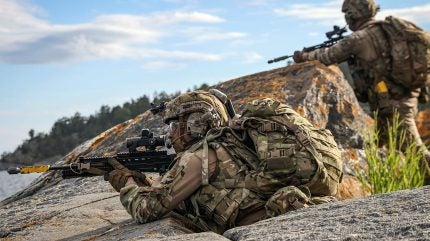
UK Royal Marines will benefit from three portable, scalable and modular 100-metre indoor firing range complexes.
The order responds to the need for more live fire training space in the UK while also reducing the need for travel and subsistence on troops to use similar outdoor facilities.
There is an option to purchase more ranges within two years. The initial ranges will be delivered by the end of March 2025. An option is also included for the provision of up to ten years of maintenance and support for each complex.
In the invitation to tender (ITT), the Royal Navy acknowledged that there is “limited infrastructure” to support live fire training in some cases following a change in the operational shooting policy.
“The lack of readily available ranges places acute pressure on deploying units, increases the financial burden on operational budgets and reduces defence training estates range availability for other users with a lower priority.”
A more agile defence estate
As of 1 April 2024, the Ministry of Defence (MoD) claimed 342,000 hectares in land holdings, or 1.4% of the total UK land mass. This estate has reduced over the past year by 1,500 hectares, and again by 600 more in the year before that.
How well do you really know your competitors?
Access the most comprehensive Company Profiles on the market, powered by GlobalData. Save hours of research. Gain competitive edge.

Thank you!
Your download email will arrive shortly
Not ready to buy yet? Download a free sample
We are confident about the unique quality of our Company Profiles. However, we want you to make the most beneficial decision for your business, so we offer a free sample that you can download by submitting the below form
By GlobalDataThis is all part of the government’s aim to optimise the defence estate according to a strategy introduced in 2016. This involved ridding itself of idle sites and saving money in the longer term. In the end, the department aims to cut down the size of its estate by 30% in 2040-41.
Nevertheless, some use has been found for idle sites such as an old Army Barracks in Pembrokeshire, Wales. Rather than closing the site, Cawdor Barracks is being considered for use as part of the Deep Space Advanced Radar Capability inititaive for intelligence-sharing among the trilateral AUKUS alliance.
As Britain transitions from the relatively quieter years of counter-insurgency warfare to a new era of global strategic competition, one would be forgiven for thinking that the military require more space. Rather, the Armed Forces need to be more agile and to maintain a persistent state of readiness.
Military readiness
Britain’s military readiness has come into question for some time now. Even the Secretary of State for Defence, John Healey, has expressed concern that while the military is in a position to conduct operations, they cannot engage in a full-scale war.
Nevertheless, an MoD spokesperson assured Naval Technology that “all UK forces have access to the relevant training required to be held at readiness to protect the UK and meet our Nato commitments. This includes access to firing ranges.”
This state of readiness, when it comes to training, is seemingly minimal according to the Navy’s ITT which stipulates that personnel must perform close quarter marksmanship annually under the transition to live fire tactical training chapter.
Likewise, pilot trainees in the Royal Air Force are said to undergo lengthy holdovers in which little to no activity is required of them. This has reduced retention in the service as well as the wellbeing of students, according to findings from Ofsted, a UK education watchdog.
With the use of the new indoor range complexes from March next year, the Commandos will be able to conduct live fire activity up to 100 metres, by up to six dismounted users or one vehicle (no more than 3.4 metres high) with a pintle weapons mount.
Its function would be to provide a 24-hour capable, controlled environment in which weapons, ammunition and equipment firing and trials can also take place.



